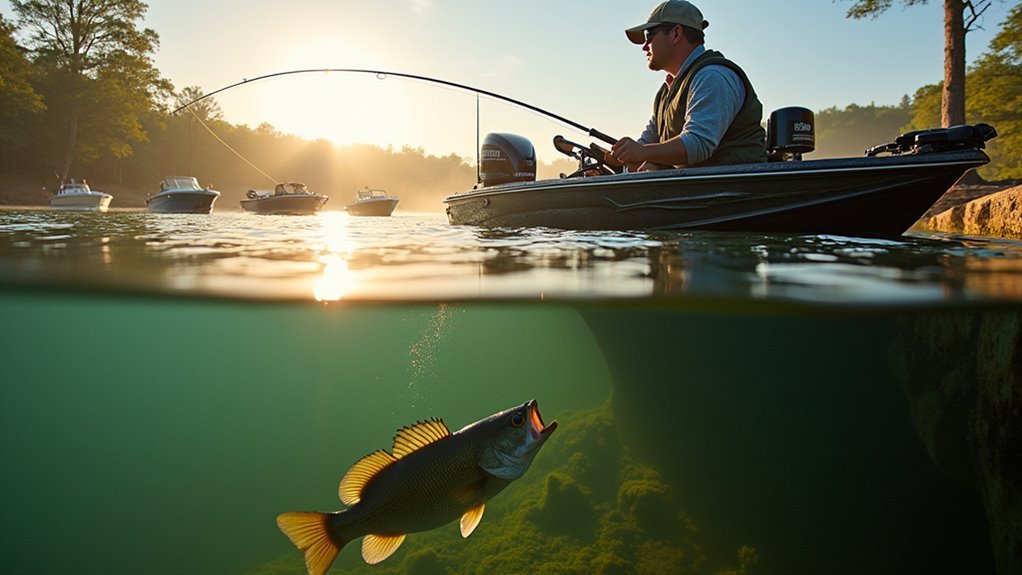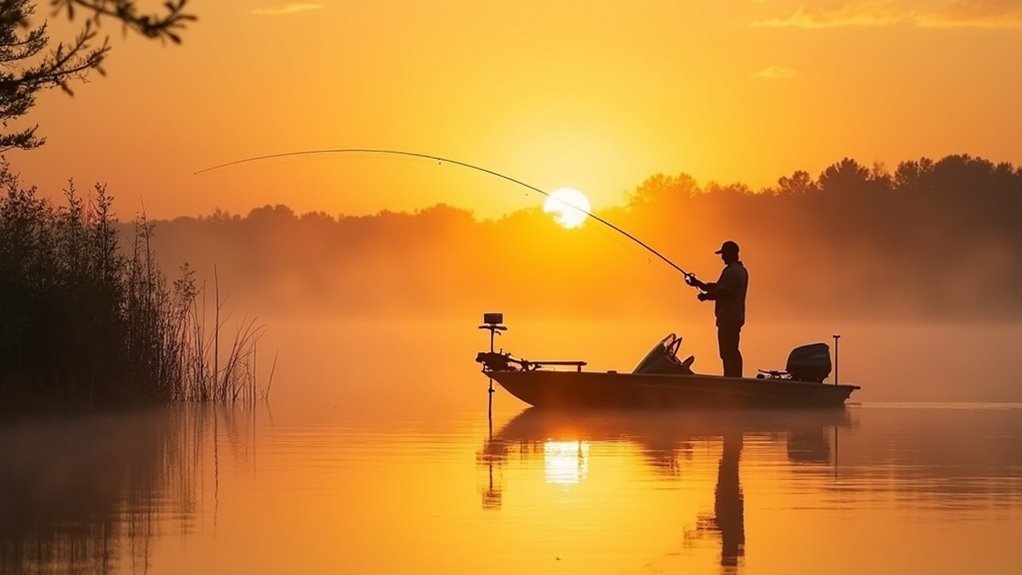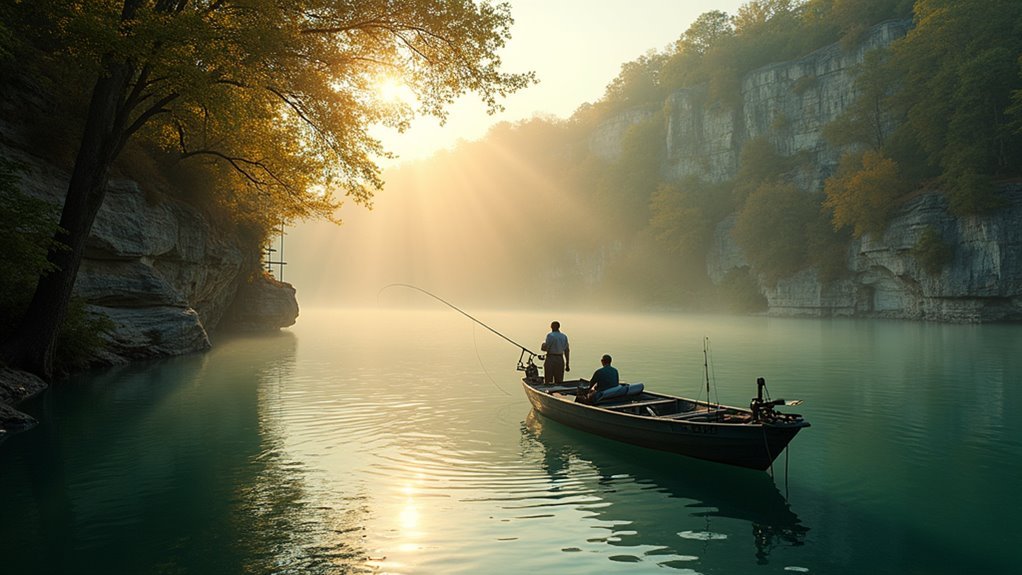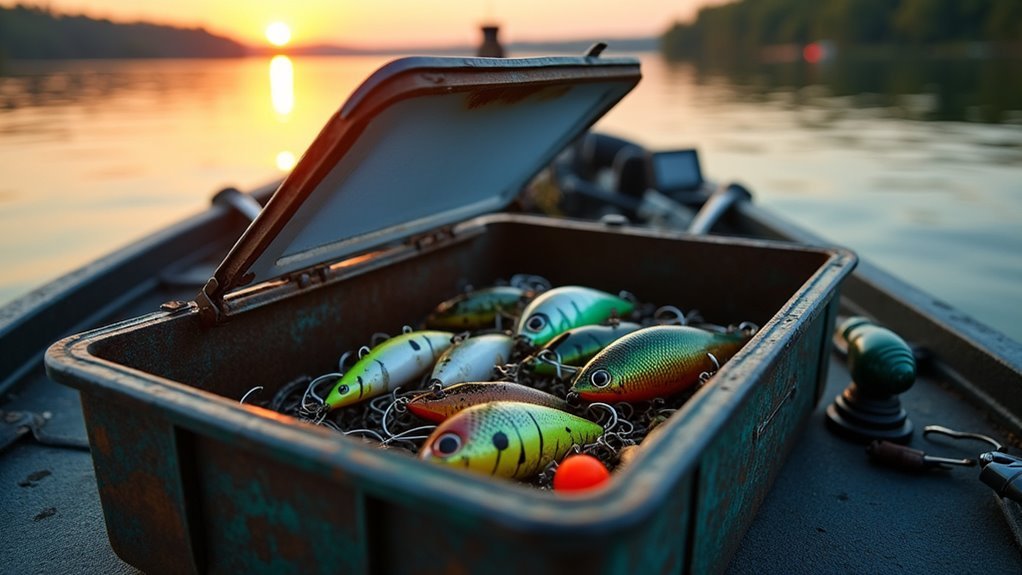We’ve discovered that dock fishing is your ticket to Lake of the Ozarks bass success. Target corners and cables for the biggest catches, especially during early mornings from 6-10 a.m. when boat traffic is minimal. Don’t overlook those abandoned North Shore docks or quiet coves between mile markers 25-35 where trophy bass hide. Shaky heads, Senkos, and buzzbaits consistently produce strikes when used in the right seasonal spots. Stick around for our complete local blueprint to landing lunkers.
The Dock Fishing Blueprint: Targeting Bass Where They Hide

When it comes to fishing success at Lake of the Ozarks, we can’t overstate the importance of focusing on docks, where bass find everything they need to thrive. These structures offer shade, cover, and a perfect ambush point for feeding.
We’ve found that targeting dock corners dramatically increases your catch rate. In spring, look for docks in coves with good spawning habitat, while summer calls for main-lake docks. We’ve hauled in some monsters by casting under cables and catwalks where bigger fish hide.
Don’t overlook those boat docks sitting on the edge of deep water – they’re gold mines when worked with spinnerbaits or soft plastics. Additionally, using a trolling motor with appropriate thrust ratings can enhance your approach, allowing for stealthy maneuvers around these prime fishing spots.
Seasonal Sweet Spots: When and Where to Fish Throughout the Year

The fishing calendar at Lake of the Ozarks shifts dramatically with each season, offering unique opportunities throughout the year. We’ve caught monsters in every month by adapting our approach as the bass change their habits.
| Season | Best Location | Top Bait | Time of Day | Notes |
|---|---|---|---|---|
| Spring | Shallow gravel flats | Senkos, Flukes | Morning | Target spawning areas |
| Summer | Deep main-lake docks | Jigs, crankbaits | Dawn/Dusk | Fish dock corners |
| Fall | Points and creek mouths | Topwater, spinnerbaits | Midday | Follow schooling activity |
| Winter | Main lake points | Jerkbaits, jig-n-pig | Afternoon | Slow presentation essential |
| Pre-spawn | Secondary points | Crawdad crankbaits | Late morning | Look for 8+ pounders! |
Dawn Patrol Tactics: Maximizing the Morning Bite

Arriving at the lake before sunrise provides the single best advantage you’ll ever have when chasing Ozarks bass. We’re talking prime fishing from 6 a.m. to 10 a.m., before boat traffic churns up the water.
Look for schooling bass near points and work buzzbait topwaters across the surface. Last summer, we nailed 15 keepers in an hour using this method! No surface activity? Switch to soft plastic worms in brush piles or rocky areas.
Dock corners are gold – we’ve pulled 5-pounders from these shadows countless times. Remember, those early birds don’t just get worms – they get bass!
Hidden Gems: Overlooked Areas Most Tourists Miss

Most tourists visiting Lake of the Ozarks stick to well-known spots, missing out on the real treasures we locals have enjoyed for years. We’ve found that abandoned, older docks on the North Shore offer incredible sanctuary for big bass. Unlike the busy main channel, quiet coves between mile markers 25-35 hold untapped populations rarely pressured by weekend anglers.
Don’t overlook the shallow gravel areas where cables meet the shoreline. We’ve pulled 5-pounders from these spots while tourists zoomed past. Early last spring, my buddy and I caught 15 bass before breakfast near a forgotten creek mouth that doesn’t even appear on most maps.
Bait Selection Secrets: What Local Anglers Actually Use

While tourists load their tackle boxes with every flashy lure from the bait shop, we locals have narrowed down our selection to proven winners that consistently produce at Lake of the Ozarks.
For post-spawn bass, we swear by shaky heads around docks and Flukes for suspended fish. During April’s spawn, slow-falling Senkos are gold on gravel flats. Come February, nothing beats a suspending jerkbait worked slowly on main lake points.
We’ve boated countless bass using crawdad-colored crankbaits near bluffs and buzzbaits during early mornings when fish are schooling. Trust us—simplicity outfishes variety every time here.
Navigating Lake Traffic: Finding Peaceful Fishing Spots During Peak Season
When summer tourists flood the lake with pontoons and jet skis, finding peaceful fishing spots becomes our greatest challenge at Lake of the Ozarks. We’ve learned to fish early mornings from 6-10 a.m. when the party crowd is still sleeping. Head for bluffs and main-lake points away from popular coves.
Last summer, we tucked into a quiet secondary point while a wakeboard competition dominated the main channel. We caught five nice bass using shaky heads while boats zoomed past 100 yards away. Lake of the Ozarks State Park also offers bank fishing with less traffic.
Frequently Asked Questions
How Do Night Fishing Patterns Differ From Daytime at Lake Ozarks?
At night, we’ll find bass move to shallower water and become more active around docks. They’re less skittish without boat traffic, making topwater lures and black/blue jigs particularly effective.
What Electronics Settings Work Best for Locating Suspended Ozarks Bass?
Finding suspended Ozarks bass is like solving a puzzle in water. We’ve found 2D sonar with sensitivity at 70% and down imaging at 800kHz works best. Don’t forget to adjust contrast for those sneaky suspended targets.
How Does Heavy Rain Affect Water Clarity and Bass Behavior?
Heavy rain muddies our waters, pushing bass shallower where they’re easier to target. We’ll find them near structure edges where clear meets stained water. They’ll strike reaction baits more aggressively.
Are Circle Hooks or Traditional Hooks Better for Catch-And-Release?
For those concerned with fish welfare, we’d say circle hooks are superior for catch-and-release. They typically hook in the corner of the mouth, reducing deep hooking and improving survival rates compared to traditional hooks.
How Do Bass Patterns Change During Winter Drawdowns?
During winter drawdowns, we’ll find bass moving deeper as they follow baitfish. They’re concentrating near channel edges, deep points, and remaining structure where water temperature’s more stable.
Conclusion
Just like Hemingway’s old man battled the sea, we’ve wrestled with the Ozarks’ waters and learned her secrets. We’ve shared our hard-earned knowledge—from dock corners that hide monsters to peaceful coves tourists never find. Now it’s your turn to put these tips to work. Remember, the best stories aren’t about the one that got away, but about knowing exactly where to cast when everyone else comes up empty.